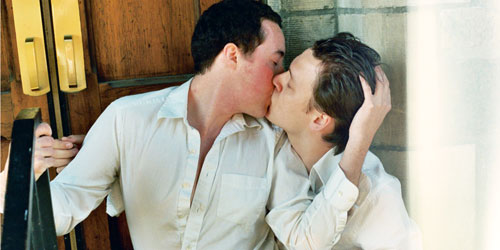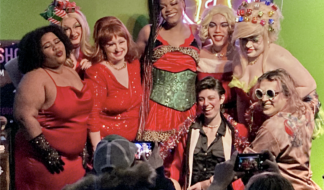
As young thespians move from college into the workplace – often with few jobs in the local professional theater industry to support them – these energetic and creative souls often leave the state or create their own small theater companies in which to ply their trades. Others, meanwhile, simply want opportunities to tell stories about THEIR lives and THEIR interests. As a result, it's companies and voices like these that help create Cool Cities and provide real-world experience for up-and-coming artists to succeed or flop outside the protective cocoon of academia.
Southeast Michigan has been a hotbed of such action in recent years, the latest of which is The New Theatre Project based in Ann Arbor. After a string of previews last month at Performance Network Theatre, the troupe has modified its inaugural effort and moved a short walking distance to Pot & Box – it's not what you're thinking, folks – where a sold-out crowd on July 16 attended the company's first-ever official opening night performance. And while "The Spring Awakening Project" has its share of flaws, there's no denying that these talented and passionate artists are a welcome addition to the community.
Based on the Frank Wedekind script of the early 1890s and NOT the currently running, award-winning musical, founder and director Keith Paul Medelis held auditions, cast his show and then early this year gave his creative team the following assignment: to write in their journals about a moment in which they realized they were no longer a child. Drama exercises followed, as did a script by Jason Sebacher that uses their work to more deeply explore six of Wedekind's 30-plus characters.
The result is slick and intriguing, but not fully satisfying – at least from this mid-50-year-old's perspective.
Wedekind's controversial play – which in 1917 was deemed pornographic after its first English-language production in New York City – is a dark and powerful look at society's treatment of children, especially during the time of their sexual awakening. His targets are many – from organized religion to the government, and from parenting skills to theories of education. And along the way he touches upon atheism, Christianity, homosexuality, death, rape and masturbation. Much of this, of course, was never spoken aloud in polite, turn-of-the-20th-century Europe or America.
Sebacher's script follows Wedekind's themes and characters quite faithfully, while adding a few twists and turns. Surprisingly, however, "The Spring Awakening Project" is much darker than its predecessor – and more disturbing. For example, whereas Wedekind presents the gay lovers as fairly happy and normal teenagers, one unexpectedly rapes the other in this production and eventually murders him. (Was this a matter of quid pro quo: Since a girl gets raped in both productions, must a boy get raped in this one, too?) And he's not the only one who lives on at the end of the original play, but doesn't in Sebacher's.
All of which makes me wonder: What is it about the lives and experiences of the show's young creators that took this project down such a darker path? (Remember, certain plot elements were influenced by their journals and other developmental work.)
Sebacher, a graduate student at Carnegie Mellon with eight prior plays under his belt, writes tight, crisp dialogue. And his story unfolds in rhythmic beats that flow quite nicely. But sudden, inexplicable changes in character displayed by various individuals don't ring true. (And why, at the end of the show, did one actress deliver a line in French when that language has absolutely nothing to do with the story? It's a pretentious moment that doesn't serve the show well. Nor does the Tooth Fairy. Yes, you read that correctly. Such intrusions into a serious theater piece MIGHT have been interesting had they occurred throughout the play and served a purpose. But not mid-way through or towards the end; it's jarring and takes the viewer out of the moment.)
Also, what's not made clear is the time period of the play. For while the costumes and dialogue seem to indicate it's set in Wedekind's late 19th century, an otherwise ingenious appearance near the end of the play by yet another mythic figure (instead of Wedekind's Masked Man) throws that into question – not only because he wasn't as celebrated then as he is today, but a line referencing Coca Cola ads firmly places the story anytime from the 1930s forward.
Other problems with the show are the result of the performance space, directorial choices and sound levels.
At first, Pot & Box seemed like a cool space in which to put on an intimate play, thanks to its oddly shaped dimensions and high-ceiling. Designer Janine Woods Thoma took full advantage of it, creating a visual feast of tall, papier-mache trees (the bark and leaves of which were made out of pages from the actors' journals and old scripts) and stars in the sky. (The story mostly takes place in the woods.) Plus, her lighting created the perfect mood for every scene.
But with limited space into which are squeezed one or two rows of seats (on three irregular sides of the playing area), a piano and a light board, little room is left for six actors to do their work. And since much of the action takes place seated on the floor or with the actors flat on their backs or stomachs, those of us in the second row often missed what was going on. (The closer the action was to you, the less of it you could see when seated in the second row.)
Plus, considerable chunks of dialogue were missed on opening night because the piano playing was too loud and drowned out the actors. (Because of that, I suspect I missed some very important plot points!) But the actors also failed to project their voices throughout the show, especially while in close proximity to one another on the floor or when competing with the cooling system (which also failed miserably to keep up with the heat generated by approximately 40 bodies and a lighting system).
So yes, "The Spring Awakening Project" has problems. But not insurmountable ones. And it's blessed with the passionate performances and fine singing voices of Luna Alexander (Wendla), Matt Andersen (Hans), Caleb Kruzel (Melchior; composer), Amanda Lyn Jungquist (Ilse), Ben Stange (Ernst) and Austin Michael Tracy (Moritz).
So for this middle-aged critic who grew up in very different times than did the eager and talented young people who created the show (and who probably has a totally different perspective on life than they do), "The Spring Awakening Project" is a play I simply can't relate to – although others, I'm sure, will. But I admire their sincerity, hard work, dedication and polish. And I look forward to observing the company's growth in the months and seasons to come – even if their concepts, messages and perspectives reflect those of folks far younger than me! Because, after all, a diversity of opinion, thought and style keeps theater vital, valuable and thought-provoking!
REVIEW:
'The Spring Awakening Project'
The New Theatre Project at Pot and Box, 220 Felch St., Ann Arbor. Friday-Monday through Aug. 2. Contains adult themes and partial nudity. $15. 810-623-0909. http://www.thenewtheatreproject.org










